 Relining in the context of sewer rehabilitation can be defined as the process of repairing a damaged sewer pipeline by inserting a liner coated with resins that is expanded into the damaged pipe to create a lining within the pipe.
Relining in the context of sewer rehabilitation can be defined as the process of repairing a damaged sewer pipeline by inserting a liner coated with resins that is expanded into the damaged pipe to create a lining within the pipe.
The Process
A resin-saturated felt tube made of polyester, fibreglass cloth or any of a number of other materials suitable for resin impregnation, is inserted or pulled into a damaged pipe. It is usually done from the upstream access point (manhole or excavation). It is possible to insert the liner upstream (e.g. from the downstream access point) but this carries greater risk. It is possible to install a liner from the downstream access point, upstream to a blind end; however, this carries the highest risk of all the CIPP installation methods. CIPP is considered a trenchless technology. Little to no digging is involved in this trenchless process, making for a potentially more cost-effective and less disruptive method than traditional “dig and replace” pipe repair methods. The liner can be inserted using water or air pressure. The pressure required for insertion can be generated using pressure vessels, scaffolds or a “chip unit”. Hot water, UV light, ambient cured or steam is used to cure the resin and form a tight-fitting, jointless and corrosion-resistant replacement pipe. Service laterals are restored internally with robotically controlled cutting devices in the larger-diameter pipe. Smaller diameters (100 mm) can be opened remotely using smaller reinstating (reinstalling?) devices designed for small diameter pipe. The service lateral connection can be sealed with specially designed CIPP materials. The resin used is typically polyester for mainline lining and epoxy for lateral lines. Since all resins shrink (epoxy resins shrink far less than poly and vinyl ester versions) and it is impossible to bond to a sewer that has fats, oils, and grease an annular space exists between the new CIPP liner and the host pipe. The annular space exists in all installations just some are larger than others and depending on the severity may need additional rehabilitation. There are multiple ways to prevent water from tracking in the annular space and entering back into the waste stream including: water swelling material (hydrophilic), lining of the entire connection and host pipe with a continuous repair (YT repair) gaskets, and point repairs placed at the ends of the host pipe and at the lateral connections.
Advantages
As a trenchless technology, CIPP does not require excavation to rehabilitate a pipeline that is either leaking or structurally unsound. Depending upon design considerations an excavation may be made, but the liner is often installed through a manhole or other existing access point. Anything larger than 60 inches must be excavated in order to install. Liner is installed as it is wet out on site in these instances. In the case of sewer lines, lateral connections are also restored without excavation via a remote controlled device that drills a hole in the liner at the point of the lateral connection. If larger than 24″ and it is safe to do so someone will reinstate laterals by hand. CIPP has a smooth interior and no joints. While CIPP can repair a pipe with bends, special design considerations must be taken into account to prevent wrinkling and stretching. CIPP can effectively reduce infiltration and leaks in pipeline systems without digging.


